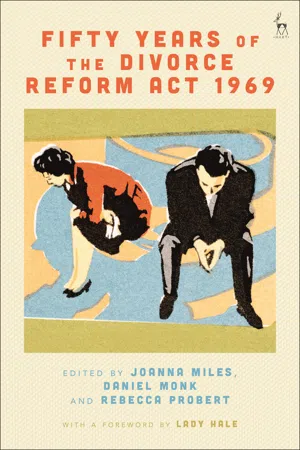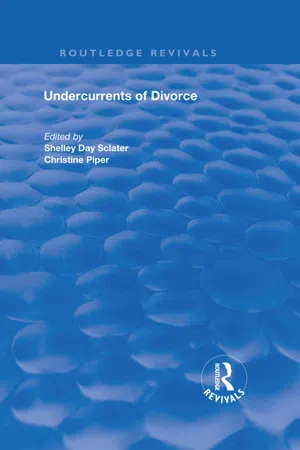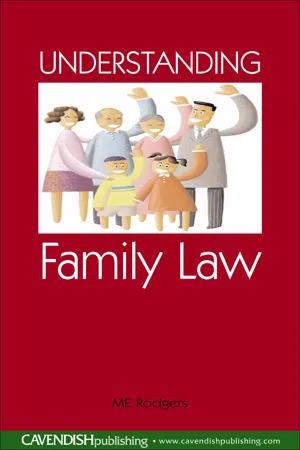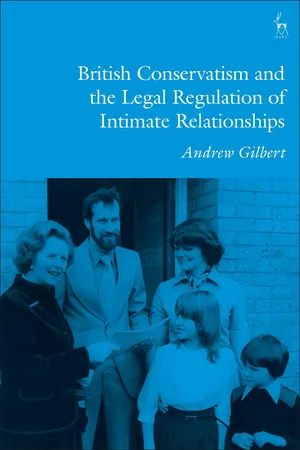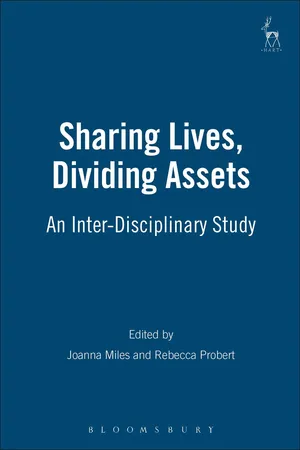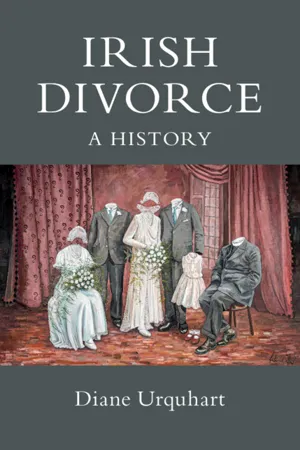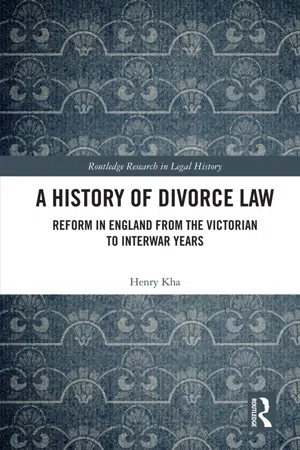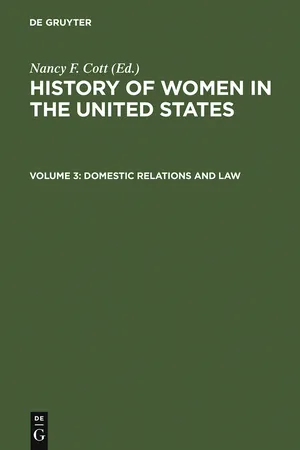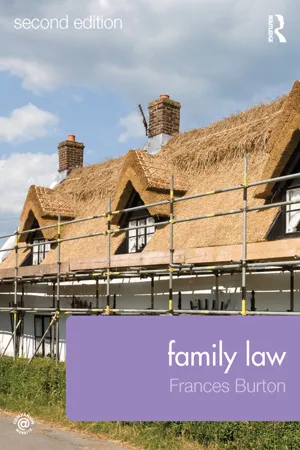History
1969 Divorce Reform Act
The 1969 Divorce Reform Act was a significant piece of legislation in the United Kingdom that made it easier for couples to obtain a divorce. It introduced the concept of irretrievable breakdown of marriage as the sole ground for divorce, allowing couples to divorce after a separation period of two years with mutual consent or five years without. This act marked a major shift in divorce law and had a lasting impact on family law in the UK.
Written by Perlego with AI-assistance
Related key terms
1 of 5
10 Key excerpts on "1969 Divorce Reform Act"
- eBook - ePub
- Joanna Miles, Daniel Monk, Rebecca Probert, Joanna Miles, Daniel Monk, Rebecca Probert(Authors)
- 2022(Publication Date)
- Hart Publishing(Publisher)
PART ONE IntroductionPassage contains an image
1 ‘Irretrievably Broken’? Introducing the Life-Story of the Divorce Reform Act 1969 JOANNA MILES, DANIEL MONK AND REBECCA PROBERTI.The 1969 Act: What It Did and Said, In ShortBy any measure, the passage of the Divorce Reform Act 1969 was a landmark moment in family law. It had a significant impact on legal practice and saw a dramatic increase in divorce. It also had symbolic significance, reflecting changes in social attitudes. But the law’s inherent tensions also exhibited prevailing contestations about public morality, conflicting ideals of citizenship and ambivalence about the reforms. And alongside and in keeping with the other key ‘permissive’ reforms of the era (in particular, the decriminalisation of abortion and ‘homosexuality’ in 1967), radical change went hand in hand with a degree of continuity.The Act, codified quite soon after its enactment into Part I of the Matrimonial Causes Act 1973, enshrined the principle that a divorce could be granted if the marriage had ‘broken down irretrievably’. Before the Act’s passage, almost all divorces had been granted on one of three fault-based grounds: adultery, cruelty and desertion.1 Of these, cruelty and desertion had only been available as grounds for divorce for a little over 30 years.2 Previously, adultery had been the sole basis on which a husband could divorce his wife. Wives, perhaps unexpectedly, had had three additional grounds to choose from; however, as these were rape, sodomy and bestiality, this hardly put them in a privileged position.3 Moreover, before 1923, a wife was not able to obtain a divorce on the basis of her husband’s adultery without establishing an additional aggravating factor: incest, bigamy, cruelty or desertion.4 - eBook - ePub
- Shelley Day Sclater, Christine Piper(Authors)
- 2019(Publication Date)
- Routledge(Publisher)
The removal of fault from divorce has not been and will not be, we suspect, easy to achieve. One of the central aims of the Divorce Reform Act of 1969 was the removal of matrimonial fault. That Act introduced ‘irretrievable breakdown’ as the sole ground for divorce but, such was the heated and ideological nature of the debates as the Bill passed through Parliament, that fault, in fact, lived on in the guise of the ‘facts’ required to prove the irretrievable breakdown. Similarly, the passage of the 1996 Act was troubled by a vocal lobby who argued that removal of fault represented an undermining of marriage and ‘the family’. This lobby was undoubtedly placated by the introduction of the ‘principles’ at the Report stage, which include a provision that ‘the institution of marriage is to be supported’ (now in section 1 of the Act), but this principle, coupled with the removal of fault, conveys powerful messages in which many tensions are manifest. The removal of fault from the legal process represents a legislative expression of the primacy of a discourse of harmony and one that prioritises a particular interpretation of children’s interests. The principle that marriage is to be supported connotes a concern that marriage should remain the preferred basis for ‘the family’ and the best forum for raising children. But the passionate nature of the divorce debates, in 1969 and in 1996, indicate that in the popular mind at least, fault remains important and significant in divorce. As in 1969, we may find that we are not able to legislate it away.At an individual level, studies show that divorcing people are deeply concerned about issues of blame, which colour their perceptions of fairness and their ideas about justice (see, for example, Davis, Cretney and Collins, 1994). For many, the notion of fault, of attributing blame to one party and exonerating the other, is what the legal system should be about, it is what ensures that justice is not only done but also is seen to be done. Brown and Day Sclater, in their chapter on the psychodynamics of divorce, argue that there are good psychological reasons why many divorcing people feel this way; faced with the loss that divorce inevitably entails, as well as the need to build a new life, the imputation of blame can feature prominently on the psychological agendas of divorcing people. These psychological ‘roots’ provide a bedrock for a culture in which divorce is pathologised and where fault goes hand-in-hand with divorce. There is clearly a tension between the kind of harmonious divorce that is envisaged for us, and the needs and expectations of divorcing people. - eBook - PDF
Divorce
Causes and Consequences
- Alison Clarke-Stewart, Cornelia Brentano(Authors)
- 2008(Publication Date)
- Yale University Press(Publisher)
People became less tolerant of marital unhappiness. In a study conducted in , researchers found that half of young mothers they interviewed agreed with the statement “When there are children in the family, parents should stay together even if they don’t get along.” But when the same women were inter-viewed in , less than one-fifth agreed with the statement. 4 The dramatic social changes of the s culminated in a divorce reform movement that swept America and Britain in the s. This reform was inspired by a rather unlikely figure: the Archbishop of Can-terbury. He recognized that existing procedures were encouraging per-jury and collusion and that adversarial procedures were stigmatizing individuals and making negotiations about child custody and support difficult. To remove the immorality—the lies and perjury—from di-vorce proceedings, the Archbishop proposed a single, no-fault ground that required a judge to grant a divorce if a marriage was “irretrievably broken.” This proposal was accepted by a study commission in Cali-fornia, and in , with Governor Ronald Reagan’s signature on the 10 The Social Context of Divorce The Social Context of Divorce 11 Family Law Act, California became the first state to adopt “no-fault di-vorce.” Under the no-fault divorce law, one spouse can dissolve the mar-riage without proving any grounds for divorce and without obtaining the partner’s consent. Decrees of “dissolution” (the new, more neutral word for divorce) are granted on the basis of “irreconcilable differ-ences.” This qualifies as no fault because it takes two to have irrecon-cilable differences, so the breakdown of the marriage is no one person’s fault. This law eliminated the double standard for men and women and helped remove the morality issue from divorce. As a result of the Family Law Act, divorce became more straightforward and honest and less contentious. - eBook - ePub
- Liz Rodgers(Author)
- 2012(Publication Date)
- Routledge-Cavendish(Publisher)
As you may be aware, the law on divorce has been subject to review over the last few years. The Family Law Act (FLA) 1996 was enacted with one of its aims being to change the divorce regime and to support the institution of marriage. While a large part of the FLA has been brought into force, Pt II, the part that dealt with divorce, was left unimplemented. Primarily this was to enable pilot studies to be carried out as to the best method for implementation. These pilot studies, and the accompanying research, were not favourable and hence Pt II of the FLA 1996 will, at some point, be repealed. This means that the Matrimonial Causes Act (MCA) 1973, despite criticism, remains in force and it is this Act’s provisions that establish how a divorce can be obtained. In addition to studying the MCA 1973 you will look briefly at the FLA 1996, but this will be to enable you to understand why the reform failed and it will assist you in learning how to evaluate the law in a critical way. You should try to approach this part of the text on the basis of why the FLA’s principles were so unworkable, and whether anything beneficial could come from it, etc. You will also be looking at mediation, a FLA concept for resolving issues in divorce, this being one of the parts of the FLA 1996 that are fully in force and operational.3.2 A HISTORICAL PERSPECTIVEEngland and Wales are perceived to have a high divorce rate – the number of divorces granted in 2003 being in excess of 148,000, although this is a fluctuating figure. This number of divorces is seen as being detrimental to the stability of family life and, indeed, detrimental to the family per se. The ability to seek a divorce, for the majority of couples who wish to do so, is a relatively recent development. Historically, divorce was available only to a few, those rich enough to obtain a Private Act of Parliament, and was often only an option for the male partner. In 1857 the concept of judicial divorces was introduced, being available where one party to the marriage was guilty of adultery and the petitioning spouse was free from any guilt. A move away from adultery as a basis for divorce came in 1937 with a widening of the categories, although the categories were all a ‘matrimonial offence’, such as cruelty, desertion, insanity or adultery. The modern law stems from the Divorce Reform Act (DRA) 1969 and was re-enacted without change in the MCA 1973. This change was intended to move away from the idea of a matrimonial offence as a basis for bringing the marriage to an end.Following the full introduction of the DRA 1969, the number of divorces increased although not immediately. However, there was over a threefold increase in decrees granted between 1968 and 1978. The Law Commission has pointed out that whilst it may be easy to blame changes to the divorce laws for increasing marital breakdown, a change to divorce law and the number of divorces are not necessarily linked and you may find it useful to look at the paper (Law Commission Discussion Paper, Facing the Future – A Discussion Paper on the Ground for Divorce - Andrew Gilbert(Author)
- 2018(Publication Date)
- Hart Publishing(Publisher)
120 Extraordinar-ily, Leigh also acknowledged as a ‘fiction’ that fault is considered by the courts but opposed the removal of that fiction because it would undermine marriage. 121 As a legislator he seemed at ease with widespread public misunderstanding of divorce law, but once Parliament made the fiction explicit in new legislation then he thought this was problematic. All of these claims around law’s agency are based on a questionable premise, namely that married people actually know what the law of divorce is. 122 No evi-dence was produced during the parliamentary debates to support this claim and its veracity must be questioned. Nevertheless, at the close of the Commons Second Reading, on behalf of the Government Jonathan Evans made a bold prediction that the Bill will lead to fewer divorces. 123 It is not possible to know if Evans’ pre-diction would have been correct, but Ian Smith attempts to explain the growth of divorce in Great Britain and concludes that legal factors play a limited role. 124 Changes in the law do impact divorce numbers, but only temporarily, facilitating the ‘burial of long dead marriages’ and giving a final push to those whose mar-riages are broken beyond retrieval. 125 What Smith discovered has had more of an impact on divorce levels is diminishing transaction costs of getting divorced and divorce settlements which are economically more favourable to women. He predicted that the FLA 1996 would have had a negligible impact on divorce levels provided the efficiencies gained through a less adversarial divorce procedure were offset by the increase in time costs as a result of the scrapping of divorce based on adultery or behaviour. 126 The whole premise of thought, reflection and consideration in the Act is startling: that divorcing couples do not otherwise properly apply their minds to the consequences of their actions. There is substantial evidence to challenge this 122 Divorcing Rhetoric from Reality 127 Davis and Murch (n 19).- eBook - PDF
Sharing Lives, Dividing Assets
An Inter-Disciplinary Study
- Joanna Miles, Rebecca Probert, Joanna Miles, Rebecca Probert, Joanna K. Miles, Rebecca Probert(Authors)
- 2009(Publication Date)
- Hart Publishing(Publisher)
This chapter will first describe how research has contributed to the develop-ment of the law which regulates money and property arrangements on divorce or separation, and then set out some suggestions for the way ahead, looking not only at the socio-economic position of men and women undergoing this process but also at the ways in which they reach their decisions about financial matters. PRAGMATISM AND THE RISE OF EMPIRICISM Until the Divorce Reform Act of 1969 and related reform of financial provision on divorce in the Matrimonial Proceedings and Property Act 1970 came into effect in 1971 (these provisions now being found in the Matrimonial Causes Act 1973), the powers of the courts in relation to finance and property on divorce and the basic principles under which they worked had not been changed significantly since the nineteenth century. The husband had a duty to provide income support, but the court had no power to make any order concerning his property, although it could do so against the property of a guilty wife. A major step forward in 1971 led (see Eekelaar, 2000) to gender-neutral provision, and the articulation of a goal: that of placing the parties as far as it was practicable to do so in the position they would have been in had the marriage not broken down (taking into account conduct). In order to achieve this aim, the courts acquired a general power to transfer property from one spouse to the other. At this time, the purpose of the law was to discourage 2 Contrast the no-fault separation ‘facts’ on which irretrievable breakdown of marriage, necessary to obtain a divorce, can be proved: Matrimonial Causes Act 1973 s 1(2)(d) and (e). The Perils of Reforming Family Law 27 divorce, by holding financial responsibilities to continue in the event of the ending of the marriage, and by penalising conduct (although the courts swiftly eroded this element limiting the definition to obvious and gross and misconduct). - eBook - PDF
Irish Divorce
A History
- Diane Urquhart(Author)
- 2020(Publication Date)
- Cambridge University Press(Publisher)
7 With 730,335 Irish-born in Britain, comprising 2.9 per cent of the population of England and Wales and 7.2 per cent of the population of Scotland in 1851, many of whom gained a deserved reputation for transience, the effect of this exclusion reached beyond Irish residents. 8 There were also changes affecting the status of a divorced woman whom the 1857 act recognised as feme sole, enabling her to exercise control over property acquired after divorce. This was not enacted in Ireland until 1865. The act also gave the courts limited power to make a protection order for a divorced wife which might enable her to exercise some control over her property which Parliament could not provide. 9 For William Brooke, barrister and most vocal nineteenth-century pro- ponent of Irish divorce law reform, the ‘comparative disability’ between the English and Irish divorce provision post-1857 was unconstitutional and its impact on women was especially marked. His 1873 report to the Statistical and Social Inquiry Society of Ireland emphasised that ‘the relief afforded by law (if relief it may be called) to such women as are afflicted with brutal or faithless husbands’ was woefully inadequate: ‘Practically . . . in Ireland no matter how infamous or disgusting may be the character and conduct of a husband, his wife can never free herself 5 Royal Commission on Divorce (1912), p. 18. Procedural amendments in 1914, 1920 and 1926 made divorce in court more affordable with the provision of financial assistance and the ability to hear cases outside of London (Gail L. Savage, ‘The operation of the 1857 Divorce Act, 1860–1910: a research note’, Journal of Social History, vol. 16, no. 4 [Summer, 1983], p. 103 and Savage, “‘They would if they could’”, p. 174). 6 W. G. Brooke, ‘Report on the differences in the law of England and Ireland as regards the protection of women’, Report to the Council of the Statistical and Social Inquiry of Ireland, 21 January 1873, p. - eBook - ePub
A History of Divorce Law
Reform in England from the Victorian to Interwar Years
- Henry Kha(Author)
- 2020(Publication Date)
- Routledge(Publisher)
176 This is important in understanding the gradual repudiation of the Matrimonial Causes Act 1857. The law in practice created unexpected problems and hardships upon those seeking a divorce. The removal of the double standard was a significant departure from the underlying principles of the Matrimonial Causes Act 1857. As the decade wore on, the challenge to the divorce law intensified.164 Cretney (n 17) 219–20.165 HC Deb 14 April 1920, vol 127, col 1792.166 Matrimonial Causes Act 1923, s 1.167 HC Deb 2 March 1923, vol 160, col 2355.168 The NUSEC was a feminist organisation formed in 1919 that sought equal rights between genders. Its origins can be traced to the National Union of Women’s Suffrage Societies. Harold L. Smith, The British Women’s Suffrage Campaign, 1866–1928 (2nd edn, Longman 2007) 91.169 HC Deb 2 March 1923, vol 160, col 2355.170 The Second Earl Russell described the bill as ‘a thoroughly bad and thoroughly inadequate Bill, but that it is practically impossible for anybody to oppose it.’ HL Deb 26 June 1923, vol 54, col 602.171 HC Deb 8 June 1923, vol 164, col 2660.172 HL Deb 26 June 1923, vol 54, col 573.173 HL Deb 11 March 1924, vol 56, col 636.174 Ibid . col 674.Knight bills
The Matrimonial Causes Act 1857 was characterised by two essential elements: the double standard between genders and adultery as the sole ground for divorce. The Matrimonial Causes Act 1923 introduced gender equality. The Matrimonial Causes Act 1937 went further and expanded the grounds of divorce beyond adultery. The removal of the double standard was not enough, because the sole ground of adultery still made divorce too difficult for many through the operation of the bars to divorce. After Labour won a majority in the House of Commons in 1929 for the first time, the Labour MP George Wilfred Holford Knight introduced a bill that proposed to extend the grounds of divorce to include incurable insanity for a period of at least five years, and to introduce a bar to divorce against petitioners who were found to have contributed to the respondent’s insanity.177 Knight limited his demand to include incurable insanity. He later explained that a more far-reaching bill ‘making drastic and far-reaching changes in the law should be undertaken only by the Government itself.’178 Despite the fact Knight was given leave to introduce the bill, Prime Minister Ramsay MacDonald indicated that the government was unwilling to facilitate further debate on the bill.179 - eBook - PDF
- Nancy F. Cott(Author)
- 2012(Publication Date)
- De Gruyter Saur(Publisher)
98, sec. 1, 1189. Christopher Lasch, Divorce and the Decline of the Family, in his The World of Nations: Reflections on American History. Politics and Culture (N.Y., 1973), 39. DOMESTIC RELATIONS AND LAW 85 their special racial concerns, 15 legislation from 1825 to 1860 pro-gressively expanded the wife's legal prerogatives and facilitated the divorce procedures. A legislative act of 1825 was significantly worded to be for the benefit of married women whose husbands have either left them, or driven them from their homes. 1 ® The law aided the abandoned wife by barring any property she had accrued after the separation from being attached to pay for her husband's debts. The burden of the law was to prevent a situation where the wealth of a hard-working and virtuous wife would inadvertently subsidize a spendthrift and negligent husband. Similarly, in 1831 the General Assembly came to the financial relief of wronged wives with an act to authorize females to obtain divorces in court without cost. Women had to procure a bond for the prosecution of their divorce petition, but if the applicant won the case, court costs could in no event be chargeable upon a female. 17 Court costs then took on a moral cost which the 1799 law had left ambiguious—female virtue was now clearly recompensed. 18 Presumably the male legislators were repelled by the prospect of a decent woman having to pay court costs after having secured a divorce from a proven scoundrel. In addition, the same law dis-pensed in the case of women only with the stipulation of the 1799 law which required the newspaper publication of the divorce suit for four successive weeks—a small procedural concession but one in-dicative of the chivalry of a legislature concerned with protecting female virture from male vice. - eBook - ePub
- Frances Burton(Author)
- 2015(Publication Date)
- Routledge(Publisher)
Children and Families Act (CAFA) 2014.It was at the time anticipated that in due course some other reforms would be brought forward but there are at present no signs of any legislative progress in this direction, and it would seem that reform of the law of financial provision is much more urgent.11However, reform has been put back on the agenda by the Law Society and Resolution (still often known as the SFLA), the Parliamentary All Party Group (which, before recent discontinuance, was considering various issues in Family Law) and Baroness Ruth Deech’s 2009 Gresham Lectures in the winter of 2009–10.Nevertheless, the present position is that in England and Wales divorce law depends on the legislation and culture of over 40 years ago, albeit that professional pragmatism has made the system work so that in effect there is already a species of divorce by consent in force, notwithstanding that that analysis is incorrect in law, and is achieved by practical use of the statutory provision which bears no little resemblance to the legal fictions by which other areas of law were developed in the Middle Ages to create the law of contract and tort.12This leads commentators to claim that the present law is hypocritical as (unless the parties want to wait for two or five years from the breakdown of the marriage) one party must take proceedings against the other on one of the fault bases in order to achieve the divorce by ‘consent’; that as a divorce law it is inappropriate as it perpetuates the need for the parties to blame one another and for the respondent to desist from defending in order to achieve the decree; and that it is inaccurate as members of the lay public regularly incorrectly state – and obviously believe – that they have obtained a ‘divorce by consent’ when this process has only been achieved by the respondent taking the advice of his/her lawyers or other advisers not to defend, which is doctrinally a substantially different situation, but nevertheless achieves the same result – the end of the marriage.
Index pages curate the most relevant extracts from our library of academic textbooks. They’ve been created using an in-house natural language model (NLM), each adding context and meaning to key research topics.
